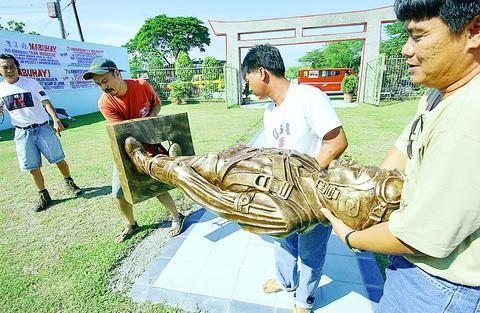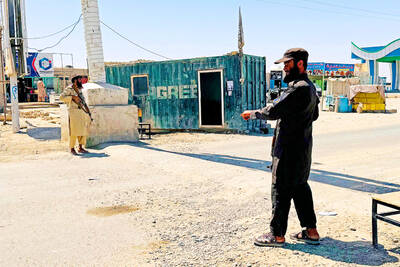In a clearing by a sugar cane field a few kilometers from the former US Air Force base at Clark in the Philippines, stands a life-size statue of a Japanese kamikaze pilot.
In any other country that was occupied by the Japanese such a monument would raise howls of protest -- but in the Philippines the worst it has elicited is a few grumbles.

PHOTO: AFP
The sculpture stands on what used to be the east Mabalacat airfield, 80km northwest of Manila, where 60 years ago Japan unleashed its suicide squadrons in a last desperate bid to turn the tide of defeat.
According to local tourism official Guy Hilbero, the aim of the statue is to promote peace "using the lessons of war."
"It is not a memorial glorifying the kamikaze pilots," he said.
"I suppose a lot of foreigners would find that difficult to understand considering we were once occupied by the Japanese," he said. "But we Filipinos are a very forgiving people. At some point you have to forgive and move on."
He said the statue, which was unveiled earlier this week in a simple, low key ceremony in front of some 200 local and Japanese officials, should be seen as a symbol.
"A symbol for all that is wrong with war. The point being that no one wins," Hilbero said.
The original design for the statue depicted a kamikaze clutching a sword and proudly leaning on a 112.5kg bomb but Hilbero didn't think it was appropriate.
Colonel Rafael Estrada, 87, founder and chairman of the veterans group Defenders of Bataan and Corregidor said: "The site is where the Kamikazes were born. That is a historical fact.
"I have no problem with that but to mark it with a full size statue of a Kamikaze pilot is, in my opinion, not right," Estrada said.
According to Ronnie dela Cruz who runs the historical society in the town of Bamban, next door to Mabalacat, the statue is a disgrace.
"It is a symbol of military power, not peace. It glorifies the kamikaze pilots and goes beyond being just an historical marker," he said.
In the final 10 months of the war, some 7,465 kamikaze flew to their deaths, 120 US ships were sunk with many more damaged and 3,048 allied sailors were killed and another 6,025 wounded.
Today, nothing remains of the airfield except for a 500m2 plot of land donated by a farmer which has been turned into a small memorial park. In 1998 the local government passed a resolution declaring the park on what was the kamikaze east airfield a "peace memorial."
Following the Leyte landings in the eastern Visayas islands by the US and the return of General Douglas MacArthur to the occupied Philippines on Oct. 20, 1944, the Japanese found themselves heavily outnumbered on the ground, in the air and on the sea.
Vice Admiral Takijiro Ohnishi met with his officers of the First Air Fleet at what was then the Mabalacat East Airfield on Oct. 18, 1944, two days before the US invasion to outline his plan for victory.
According to Rikihei Inoguchi and Tadashi Nakajima in their book The Divine Wind, Ohnishi said: "In my opinion there is only one way of assuring that our meager strength will be effective to a maximum degree ... That is to organize suicide attack units composed of Zero fighters armed with 250kg bombs, with each plane to crash-dive into an enemy aircraft carrier."
Inoguchi once said in an interview: "No one welcomes death but it is more understandable if one bears in mind that, considering the heavy odds that our fliers faced in 1944, their chances of coming back alive from any sortie against enemy carriers was very slim, regardless of the attack method employed."
The first kamikaze unit was born on Oct. 20 and was led by 23-year-old Lieutenant Yukio Seki. On Oct. 25, Seki and four other pilots, aged from 19 to 20, climbed aboard their Zero flying bombs and took off from the Mabalacat. Three hours later Seki flew his aircraft into the flight deck of the aircraft carrier USS St. Lo. The ship sank within 20 minutes with a loss of 114 of its 860 crew ... and the world's first human flying bomb had been born.

‘EYE FOR AN EYE’: Two of the men were shot by a male relative of the victims, whose families turned down the opportunity to offer them amnesty, the Supreme Court said Four men were yesterday publicly executed in Afghanistan, the Supreme Court said, the highest number of executions to be carried out in one day since the Taliban’s return to power. The executions in three separate provinces brought to 10 the number of men publicly put to death since 2021, according to an Agence France-Presse tally. Public executions were common during the Taliban’s first rule from 1996 to 2001, with most of them carried out publicly in sports stadiums. Two men were shot around six or seven times by a male relative of the victims in front of spectators in Qala-i-Naw, the center

Incumbent Ecuadoran President Daniel Noboa on Sunday claimed a runaway victory in the nation’s presidential election, after voters endorsed the young leader’s “iron fist” approach to rampant cartel violence. With more than 90 percent of the votes counted, the National Election Council said Noboa had an unassailable 12-point lead over his leftist rival Luisa Gonzalez. Official results showed Noboa with 56 percent of the vote, against Gonzalez’s 44 percent — a far bigger winning margin than expected after a virtual tie in the first round. Speaking to jubilant supporters in his hometown of Olon, the 37-year-old president claimed a “historic victory.” “A huge hug

Two Belgian teenagers on Tuesday were charged with wildlife piracy after they were found with thousands of ants packed in test tubes in what Kenyan authorities said was part of a trend in trafficking smaller and lesser-known species. Lornoy David and Seppe Lodewijckx, two 19-year-olds who were arrested on April 5 with 5,000 ants at a guest house, appeared distraught during their appearance before a magistrate in Nairobi and were comforted in the courtroom by relatives. They told the magistrate that they were collecting the ants for fun and did not know that it was illegal. In a separate criminal case, Kenyan Dennis

The US will help bolster the Philippines’ arsenal and step up joint military exercises, Manila’s defense chief said, as tensions between Washington and China escalate. The longtime US ally is expecting a sustained US$500 million in annual defense funding from Washington through 2029 to boost its military capabilities and deter China’s “aggression” in the region, Philippine Secretary of Defense Gilberto Teodoro said in an interview in Manila on Thursday. “It is a no-brainer for anybody, because of the aggressive behavior of China,” Teodoro said on close military ties with the US under President Donald Trump. “The efforts for deterrence, for joint resilience